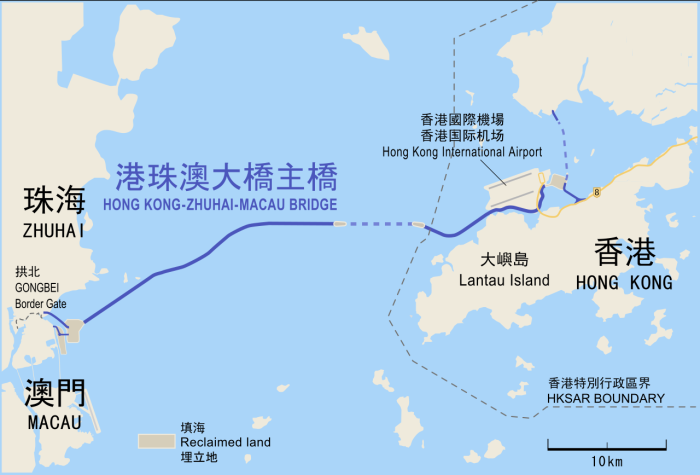



港珠澳大橋(HZMB)は、高架橋、斜張橋、沈没トンネル、人工島で構成され、珠海、マカオ、香港を結ぶ全長29.6km(18マイル)の橋です。HZMBを香港の高速道路交通網に効果的に接続するために、香港でも一連の交通施設が整備されました。
香港連絡道路 (HKLR) は、こうした交通施設の 1 つです。全長約 12 km (7 マイル) の 3 車線の高速道路と路肩で構成され、香港特別行政区の境界にある香港特別行政区境界管理局と香港国際空港島の北東海域にある香港境界通過施設を結びます。
構造ヘルスモニタリング (SHM) とメンテナンス管理システム (MMS) のパフォーマンス仕様は、HKLR リファレンス デザインに基づいています。SHM と MMS は、SHM と MMS の HKLR リファレンス デザインの機能要件を維持していますが、次の 9 つの機能強化が含まれています。
- 橋脚セグメント内の接着された内部ポストテンション(U字型垂直)緊張材の直接監視(応力と緩和)
- デッキセグメント内の非接着外部ポストテンション緊張材の直接監視(応力と緩和)
- 橋脚セグメントに埋め込まれた鉄筋の腐食状態の間接監視(腐食性ガスの濃度)
- 視程と降水量を直接監視(降水量のみではなく)
- 加速度計を使用して、船舶の衝突や地震活動による橋梁への影響を監視する
- 高速道路交通監視の精度と有効性の向上
- 橋脚の横桁の監視
- 橋脚支持部の選択された箱桁の上部フランジの腐食監視の強化
- たわみ導出のための中間スパンでの強化されたひずみ監視
Campbell Scientific の SHM システムは、HKLR リファレンス設計の要件に従って、HZMB の長期的かつ動的な状態と健全性を監視します。多機能測定および制御ユニットである CR6 は、コア データ取得ユニット (DAQ) として使用されます。DAQ は、腐食セル、バイブレーティングワイヤひずみゲージ、バイブレーティングワイヤ ロード セル、温度センサー、および 3D サーボ型加速度計の収集と信号状態の測定に使用されます。
HZMB SHM システムは合計で 46 台の CR6 ユニット、90 台の CR1000 ユニット、および数百台の拡張周辺機器を使用して、2,700 台を超えるセンサーを測定します。このセンサー、データ取得、およびデータ転送の組み合わせにより、意思決定者は橋の完全性と寿命を確保し、必要なメンテナンスを実施できるようになります。
SHM データの重要な部分には、1,200 個を超えるバイブレーティングワイヤ センサーからの構造ひずみとロード セルの測定が含まれます。これらのセンサーは、Campbell Scientific CDM-VW305 (または新しいバージョンの VWIRE305) によって測定されます。CDM-VW305 は、特許取得済みの VSPECT™ テクノロジーを使用して、動的で同時かつノイズのないデータを提供します。
ケーススタディの概要
アプリケーション
橋梁の健全性監視場所
香港、中華人民共和国使用製品
CDM-VW305 AM16/32B CR6 AVW200 CR1000寄稿者
Gary Su, Campbell Scientific (Beijing) Co., Ltd.参加団体
Earth Products China Limited計測項目
荷重、振動、衝撃、天候(圧力、降水量、風速、風向、温度)、変位、ガス濃度(腐食)、静的および動的ひずみ、交通データ関連ウェブサイト
The World’s Longest Bridge over the Sea – Hong Kong & the Mainland Got ConnectedPDFで見る